Life Skills and Traditions
Long ago, Indian families had everyday lives much like we do today. Homes had to be built and kept neat. Treasures, tools, and toys had to be carefully stored. Food had to be prepared for storage and cooked. Clothes had to be made and repaired. People found different ways to do these things, depending on what their homeland(s) offered.
For the Nez Perce in the Blue Mountains region of what is now eastern Washington and eastern Oregon, hunting, fishing, and gathering were important traditional activities.
Some 3,500 years ago, the climate in this region was more moist and cool than at perhaps any other time since the Ice Age. Wallowa Lake, in the heart of the Nez Perce homeland, was created by glaciation; the Wallowa Mountains were carved by nine major glaciers during the last two million years.
Flooding and erosion over the years changed the availability of river resources in the lower lands, and much of the hunting and food-gathering activity of the Nez Perce and other tribes moved to the upland country. Because of this, more Indians than at any other time lived in the Blue Mountains. This period ranged from 2,500 to 4,200 years ago.
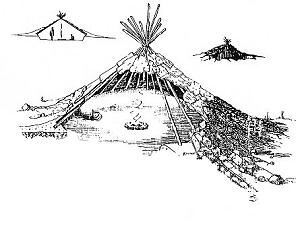 Later, approximately 2,500 years ago, environmental conditions and the regional climate shifted and became more like those of today. Salmon once again became a focal point of local resources and economies.
Later, approximately 2,500 years ago, environmental conditions and the regional climate shifted and became more like those of today. Salmon once again became a focal point of local resources and economies.
Villages of numerous pithouses grew up along the rivers, and small family groups made seasonal foraging trips throughout the Blue Mountains and the Wallowas. They hunted game and gathered a variety of different foods, including huckleberries and camas roots.
"What's for dinner!"
When Europeans came to the New World, they found the Indians eating unusual foods. The Europeans had never seen or tasted corn, potatoes, tomatoes, or melons—all grown in Indian gardens. Indians also showed them how to grow beans, squash, and pumpkins.
When Columbus landed in the Americas, he discovered people tending cornfields 18 miles long.
 Huckleberries grow low to the ground in the mountains; they are similar to blueberries but are smaller and more tasty. They are still a favorite of the Nez Perce and others today; they are used in jams, jellies, and pies.
Huckleberries grow low to the ground in the mountains; they are similar to blueberries but are smaller and more tasty. They are still a favorite of the Nez Perce and others today; they are used in jams, jellies, and pies.
Huckleberries and other berries such as serviceberries and currants were often used by the Nez Perce to make a staple food called pemmican.
Meat is sliced very thin, then dried, and then pounded or ground with stones to a dry powder. Chopped dried berries are added to the powdered meat, and then melted fat (such as deer fat or buffalo fat) is mixed in.
This mixture, when finished, would keep well and was very tasty and nutritious. The closest thing we have to this today would be rather like mincemeat pie, which is usually a mixture of meat, fruits, and spices.
Pemmican Recipe
You can make something very much like pemmican at home. Try this recipe:
- 1 cup beef jerky, very finely shredded
- ½ cup dried cranberries or cherries, chopped
- ¼ cup unroasted sunflower seeds
- 2 tablespoons peanut butter, melted
- 1 tablespoon butter, melted
Mix everything together and form it into small balls or flatted cookie shapes. Chill in the refrigerator overnight.
Click here for more recipes and information about the traditional foods of the Nez Perce
The Tipi
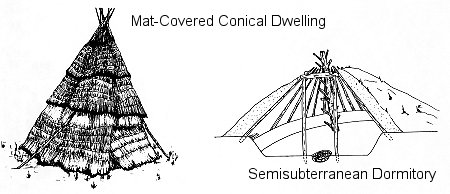 The Indians on the Plains hunted the huge herds of buffalo that roamed the grasslands. They used the meat, the hides, the bones, and virtually all parts of the buffalo to make almost everything they needed. The buffalo didn't stay in one place but roamed across the prairies in search of areas where grass was plentiful. The people followed them, and so they needed portable homes that could be moved quickly and easily.
The Indians on the Plains hunted the huge herds of buffalo that roamed the grasslands. They used the meat, the hides, the bones, and virtually all parts of the buffalo to make almost everything they needed. The buffalo didn't stay in one place but roamed across the prairies in search of areas where grass was plentiful. The people followed them, and so they needed portable homes that could be moved quickly and easily.
Some Indians who did not move around so much made homes from sticks and poles and bark—these were called wickiups, like the one on the left below. It's pronounced "wicky up."
The Nez Perce and other tribes called their beautiful portable homes "tipis." You will often see the word spelled tepees or teepees, but the correct spelling is tipi. It means "living place."
Tipis were made from buffalo skins held up by poles. The poles were most often made from lodgepole pine—so named because the trees grow tall and slender and strong and are just the right size and strength for tipi poles or "lodge" poles. The bark is removed from the tree as soon as the tree is cut down; if the bark is left on the tree for very long it hardens up and can't be removed. The peeled poles are pretty and strong.
It took between 10 and 40 hides for one tipi, depending upon how big the buffalo were and how big the tipi was, and new tipis were made in the spring to replace old ones that had worn out. Modern tipis are made from canvas.
The inside and outside of a tipi was often decorated with "paint" made from natural dyes and colors. The front of the tipi was laced together with sticks, and the top of the tipi had "smoke flaps" that could be held open with poles to let smoke out or folded shut to keep out snow and rain. In the heat of summer, the bottom could be rolled up to let a cool breeze pass through.
The big difference between a tent and a tipi is the tipi's liner. This is a short wall of hides that is strung around the poles on the inside of the tipi cover. It makes the tipi like an "envelope house" where the cold air from outside enters at the bottom of the tipi cover, goes up several feet between the cover and the liner, then enters the tipi already pre-warmed. It creates a ventilation system that ensures that the tipi is cool in summer, warm in winter, and not nearly so smoky or wet as a tent. It's an engineering marvel.
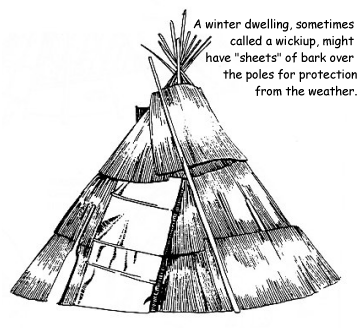
Oftentimes in the spring, all the members of a tribe gathered at one great camp. A council tipi or "lodge" was built in the center and the different bands or family groups put their tipis in a circle around it. Each band had a certain section of the circle so that people could find each other easily. A person would always know where to find an old friend because their tipi would be in the same place each spring.
When women gathered together to work on a new tipi, they enjoyed a special feast. It took about a day for them to make a new tipi.
When it was time to move the tipis, the women did the work, too. Generally speaking, two people who are taking their time can put up or "pitch" a large tipi in about 20 minutes. In contests, though, two Indian women could put up a tipi in less than three minutes! When it was time to move, the women would take down (or "strike") the tipi; it was rolled up and tied to a travois, along with the other things to be moved.
TIPI NOTES
The Crow tribe had some tipi lodges so large that 40 men could eat dinner together in one.
Some families made small "dog house" tipis for their dogs. When it was time to move on, the dog's tipi was taken down and tied to a travois that the dog pulled to the next camp. Mothers also made toy tipis for their daughters to play with.
A tipi door always faces east so that the wind blows against the back of the tipi, and the rising sun will warm and wake the sleeping family.
Learn to make a toy tipi on the Make It Yourself! page.
Parfleche
The Nez Perce made large bags, or suitcases, like envelopes to store and carry their food and clothing. Parfleche, pronounced "parflesh", was made from hides, and was often beautifully decorated. They were easy to store inside the tipis and could be hung from the tipi poles. They could also be stacked on a travois for moving.
Travois
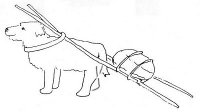 The Indians who lived on the Plains traveled a lot, following the herds of buffalo and moving seasonally to areas with good supplies of other foods. They didn't use carts or wagons but instead made a travois to carry their belongings. Two long poles were tied together, and a person could hold the ends of the poles over their shoulders. The other ends of the poles would drag on the ground. Tipis, clothing, and other items were packed and tied onto the poles. Parfleches full of food and tools were tied on top.
The Indians who lived on the Plains traveled a lot, following the herds of buffalo and moving seasonally to areas with good supplies of other foods. They didn't use carts or wagons but instead made a travois to carry their belongings. Two long poles were tied together, and a person could hold the ends of the poles over their shoulders. The other ends of the poles would drag on the ground. Tipis, clothing, and other items were packed and tied onto the poles. Parfleches full of food and tools were tied on top.
For many years, Indians used dogs to pull travois poles that were fastened to a harness made of strips of rawhide.
After the Spanish ships brought horses to the New World, the Indians used horses to pull the travois piled with their belongings. Children could ride on top of the load.
Some tribes made small pole carriages on top of the travois for young children to ride in, so they wouldn't fall off and get hurt during travel.
Find out how to make your own dog travois on the Make It Yourself! page.
Canoes
People living near rivers or lakes built small boats from whatever was available. They used reeds, sewn skins, hollowed-out tree trunks, or tree bark. The Iroquois made canoes from elm or spruce bark fastened to a wooden frame. Their canoes were very lightweight and easy to carry. The Paiute Indians in southeast Oregon and northern Nevada collected armloads of tule reeds (pronounced too-lee), which are like cattails only thinner, and bound them together for rafts and canoes. They could slip quietly over a lake or marshy area for hunting birds and fishing.
Most canoes were steered with wooden paddles. On rivers where the water was too fast or too shallow, the canoe could be carried across land for a ways, or "portaged."
Learn to make your own toy canoe here!
Fishing Lures
 Fish were an important food for Indian families. They were caught in many different ways.
Fish were an important food for Indian families. They were caught in many different ways.
Some tribes made hand-knotted nets, both large and small. Some of the tribes in the Pacific Northwest still fish with large dipnets, from a platform built up above the edge of the riverbank. Others use a seine net (pronounced "sayn") to catch much fish at once.
Some tribes made a fish trap from sticks. Others built dams with rocks, dirt, and fallen trees; they would then scoop the fish from the water with baskets.
Some tribes in the Southwest used special plants to catch fish. They ground up parts of these medicinal plants and tossed the powder into the water of a small pool or pond. The poison stunned the fish so that they floated to the top of the water and the people could pick them up easily.
Some fishermen tied a lure made of feathers to a line and dangled it in the water. When a fish came up to it, the fish was speared.
Or, much like flyfishing today, Indians made a hook with feathers to imitate an insect or tiny fish that the larger fish would bite. They made the fishhooks from sharpened pieces of bones, antlers, shells, wood, or even cactus spines.
Drumbeats
 Indians traditionally used drums with most dances and songs, and they still do. Drums can be made from many different materials; the simplest drum was a hollow log with a piece of rawhide covering the end. The drummer tapped on the rawhide "drum head" with his hands or a stick.
Indians traditionally used drums with most dances and songs, and they still do. Drums can be made from many different materials; the simplest drum was a hollow log with a piece of rawhide covering the end. The drummer tapped on the rawhide "drum head" with his hands or a stick.
"Water drums" were used by some tribes; a log was hollowed out on one end and about an inch of water was poured inside. A hide (from buffalo or deer or other animals) was stretched and tied tightly over the open end. The water inside changed the drum's sound.
Drums were usually round, but people in the northwest part of California also made and used square drums.
Find out how to make your own drum on the Make It Yourself! page.
A Bounty of Beads
The Nez Perce put beads on many things, belts, clothing, shoes, horse gear, tipis, cradleboards, and, of course, around their necks!
Beads were made from a variety of materials that people could find or trade for. Shells, bones, pebbles, claws, nuts, seeds, porcupine quills, dried berries, deer and elk antlers, buffalo horns, pieces of metal, hardened clay, birds' talons—all of these and more were used as decorative beads. Holes were drilled into beads with stone or wood tools. In later years, they traded with fur trappers for glass beads made in Europe.
"Pony beads" were single-color glass beads that were brought West on horsepack strings for trading. "Seed beads" are tiny beads that the Indians sewed onto clothing to create fancy designs.
Shell gorgets were often worn by Indians in the southeastern part of the United States. Others carved shapes from shells and other materials using tools made from bone or stone; the tools had to be harder than the shells to carve them. These pendants were worn around the neck.
Find directions for making your own beads and necklaces, even an imitation bear claw necklace, on the Craft It Yourself! page.
Pipe Bone Breastplate

Many of the people living in the Plains and Plateau areas wore breastplates for decoration. They were first made from the narrow dentallum shells acquired in trading with the coastal tribes.
Later they were made from buffalo and other bones and were called "pipe bones." Settlers made them to trade with the Indians, too. Click here to Craft It Yourself!
Clothing - Vests, Breechcloth, Leggings, Cuffs, Anklets, and Dance Bustles
The Nez Perce and other tribes made warm and beautiful clothing from animal hides or fabric they traded for.
Vests were useful, easy to make, and often beautifully decorated. Geometric designs were favored, but floral designs were often used, too.
Buckskin was a favorite material. It is made from the hide of a deer. (Buckskin can be made from elk hide, also, but it is much heavier!) First, the hide is soaked, then the hair is scraped off using a sharp tool. It's a lot of work to get all the hair off. After the hide is scraped very clean, it's like thin dry leather. It's soaked again overnight in a special mixture to make it soft, like a conditioner, and then it's stretched and pulled and stretched as it dries to make it soft and pliable like a nice suede or velvet fabric. After that, the buckskin is smoked, not like a pipe but in a different way. It is hung up above a slow and gentle fire in a lot of smoke for a long time. The smoke conditions and preserves the buckskin and makes it kind of waterproof and gives it a special color and fragrance.
Indians wore breechcloths made of buckskin or other fabric, 12 inches wide and about 6 feet long. They were draped in front and back over a belt at the waist. They were worn by boys and men, and tribes made them in different styles and from various materials.
Decorated bands were often worn by the Nez Perce and other tribes on the wrists and arms. They weren't very practical for daily work or hunting but were worn for ceremonies, feasts, and dances, and they still are today. These cuffs were usually made from buckskin or rawhide and were decorated with beads, shells, and fringe.
Not meant for everyday wear, anklets were worn for dancing -- and they still are worn today at pow-wows and Indian dance competitions. Their graceful sway and bounce add to and enhance the dancer's movements. Some of the Indians in the Northern Rocky Mountain areas used the long white hair of mountain goats for their anklets. People in other areas used grass, plant fibers, or yarn made from sheep's wool.
Dance bustles are used for extra decoration and drama in ceremonial dances. Some big bustles made with lots of feathers look a lot like certain birds during mating dances, like wild turkeys and sage grouse for example, who fluff up their feathers and look very fancy and dramatic while they "dance" during the mating season.
Learn how to craft your own clothing and beaded headbands on the Craft It Yourself! page.
Face Paint
You have probably seen face-painting booths at fairs and festivals for fun. But Indians painted their faces and bodies for many reasons besides fun. They painted their bodies with designs to protect them before they went to war; they painted their faces for beauty, just as girls and women now use makeup. They used paints to protect their skin from sun and wind, just as we use sunscreen today. Paint also kept flies, bees, and other annoying insects away, the same way we use bug spray today.
Sometimes people painted their faces to show that they belonged to a certain club or society. Faces were painted for ceremonies, or to mourn someone who had died.
Cosmetic note: Besides face painting, many natural sources were used cosmetically. Walnut hulls, for example, were rubbed onto grey hair to make it dark again. Rattlesnake grease made a good skin softener.
Indians made the paints they used out of special clays, charcoal, berries, and moss that they ground up. They used stones to grind the materials into powder and then mixed the powdered dye with animal fat.
A good sunscreen was made by rubbing buffalo fat onto the face, spreading powdered paint over it, and then rubbing it in. Some warriors painted their faces with streaks running down from their eyes to show that they were crying for the success of their expedition. Scouts would paint their faces white to symbolize the wolf, whose power was thought to be of great help when scouting.
An Indian could show others that he wanted to be left alone, or had fallen in love by painting his face black and then using his fingernails to scrape a zigzag pattern from his hairline down to his chin.
Colors of paint meant specific things. Most of the tribes used colors to indicate these meanings:
- black = death
- red = power and life
- blue = sky
- yellow = joy and victory
- white = peace
War Bonnets
Today, soldiers earn medals and ribbons for acts of bravery in the military. Indian warriors earned eagle feathers that were displayed on headbands.
Warbonnets were treasured and worn by men who had earned the right to wear each feather by doing a brave deed. A council would listen to the man tell about the experience, and then decide if he deserved the honor of wearing another feather.
If a man won more honor feathers than he could fit on the band around his head, he could add rows of feathers hanging down his back.
Some men won so many honors that their bonnets dragged on the ground, so they put the extra feathers on a lance or pole for display.
Eagle feathers were serious medicine and were used because they were hard to get and because the eagle was a powerful bird. The wearer hoped he might get some of the eagle's power from the feathers.
You can make different styles of warbonnets. The Blackfoot bonnet has all the feathers sticking up around the headband. The Apache bonnet is a cap with feathers that droop over the head all around.
Western Plains tribes wore bonnets that went over the back, sometimes reaching the ankles.
Special Shield
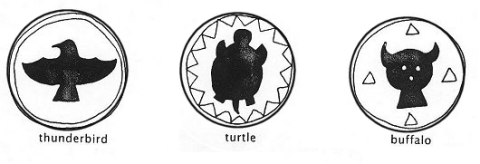 A warrior made a special shield and used it for protection. It was held in one hand during battle to deflect arrows and bullets from attackers, and it also gave spiritual protection to its owner.
A warrior made a special shield and used it for protection. It was held in one hand during battle to deflect arrows and bullets from attackers, and it also gave spiritual protection to its owner.
A man-made his shield carefully and usually decorated it with designs he had dreamed about. Special feathers and small bags of precious stones or amulets were tied onto the shield for good luck.
The shield was displayed in a special place in the home and was usually buried with the man when he died.
Learn to make your own shield on the Make It Yourself! page.
Coup Stick
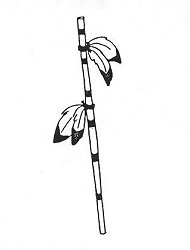 In many tribes, the highest honor that could be earned was touching a live enemy with the bare hand or a coup stick.
In many tribes, the highest honor that could be earned was touching a live enemy with the bare hand or a coup stick.
Coup is pronounced "coo" and is used today to mean "score" or "achievement." It is French for "a hit" and rhymes with blue.
Many warriors took coup sticks with them into battle. A warrior who got close enough to an enemy to touch him with a coup stick was considered far braver than one who killed an enemy with a bow and arrow from a distance. An eagle feather could be earned for each coup in battle. Some daring warriors went into battle armed only with their coup stick! There were war societies called Kit Foxes and Crazy Dogs. They were clubs that met and decided how points could be earned by members who were counting the coup. Coup sticks were about the same height as the man. They were decorated with feathers, fur, and beads.
Learn to make your own coup stick on the Make It Yourself! page.
Pictographs
Pictographs are paintings that were done on rocks, cave walls, or cliffs alongside rivers, many of them over a thousand years ago. The Indian artists used ground-up clay, sand, or plant dyes mixed with coloring and binding agents such as blood, eggs, or tree sap.
Some of the early pictograph artists painted with their fingers. Later, though, they made brushes, pens, and other tools from sticks, animal hairs, or plant stems. Some of them spattered paint by blowing through a hollow reed or flicking colored pigments off a frayed stiff/ended stick.
Learn to make your own pictograph paintings on the Make It Yourself! page.
Sign Language

The Indian peoples of North America spoke over 300 different languages. Many of the tribes traveled and traded with other tribes who didn't speak their language. How could they talk to each other? They invented a silent way of speaking with their hands.
Sign language seems to have developed on the Plains. The Kiowa, Sioux, Arapaho, Cheyenne, and Blackfoot understood and used sign talk with each other. In 1885, there were more than 110,000 sign-talking Indians in the United States, and 200 years ago, there were at least 600 tribes in North America who spoke 300 different languages.
Using silent hand signals also came in handy when hunters sneaked up on a buffalo herd. They could signal each other without making a sound that might scare the animals away. Indians also used sign language to speak with traders or to make treaties between warring tribes.
Sign language is a bit different from spoken words. To ask a question, you must make the sign that means "question" first. Use the sign for "question" for the words: what, where, why, and when.
For example, if you want to ask, "What is your name?" you make the sign "question," then "you," then "called." "How old are you?" becomes "question," "how many," "you," "winter." (Many tribes kept track of the years by counting the winter.)
"I'm going home" is signed with "I," "go," "house." It's signed like this:

Games and Activities
People everywhere have always enjoyed making up and playing games. Games were taught to children, who remembered them and taught them to their children. Games have been played for learning, for entertainment, or even for worship.
Many different games have been passed down by Indian ancestors. Games were played in all tribes, by both grown-ups and children. A lot of time was spent making the game pieces, learning the rules, and practicing the skills to be good at the games. They liked games of chance with dice made of things they found around them. They liked games played in teams, such as ball games. They also played games of skill that kept them strong for the work they needed to do, like hunting. One example would be the Stick Game.
One of the biggest differences between Indian games and white people's games is the concept of "winner" and "loser." Many Indian games do not have a "loser." Unlike many white people's games, teamwork is far more important in Indian games than the score is.
Sometimes only certain people were allowed to play a certain game. Perhaps it was a game only for girls, for example, or only for warriors. And some games could only be played at certain times of the year.
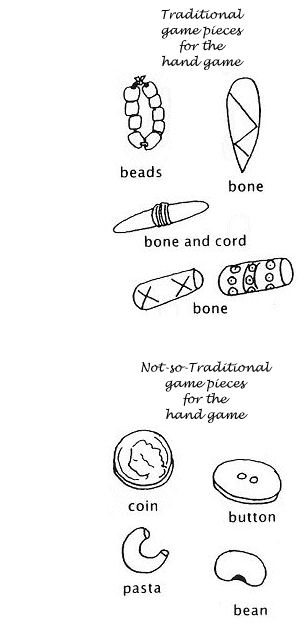
Toys
Nez Perce girls and boys played with toys that helped them learn how to be grown-ups. Their parents and grandparents made small baskets, pots, bows and arrows, horses, and even tipis for the children to play with. The girls often played "house" while the boys pretended to hunt.
Little girls sometimes put real puppies in toy cradleboards and carried them around pretending they were babies.
Sometimes they would make a small travois by lashing lightweight poles or branches together and strapping them to a dog. The children piled their toys on the travois and pretended they were moving camp with their horses.
Plains children enjoyed little villages of small tipis made by their parents. The girls worked around the pretend camp while the boys hunted. If the boys caught a prairie dog or squirrel or rabbit, the girls would roast it over a small fire. A little feast that delighted their parents.
Storytelling
Telling stories was popular with all Indian tribes. A favorite storyteller or the chief often would tell stories about the tribe's past, or stories that explained religious beliefs. Adults and children enjoyed listening to stories, just as we do now. They told stories for entertainment during long winters and to pass on the beliefs and values of the people. Children were taught many stories, and they kept them in their memory to share with their children.
Stories from Europe that we call fairy tales begin with "once upon a time." Indian stories often begin with "before the people came."
Storytelling was a special activity, and each tribe had different rules about it. The White Mountain Apaches, for example, told stories only between dusk and dawn and when it was cold.
Indians liked to use stories to teach lessons about how to act and how to live with others. They also used stories in healing ceremonies.
Some stories were so important they could only be told by certain people at certain times.

